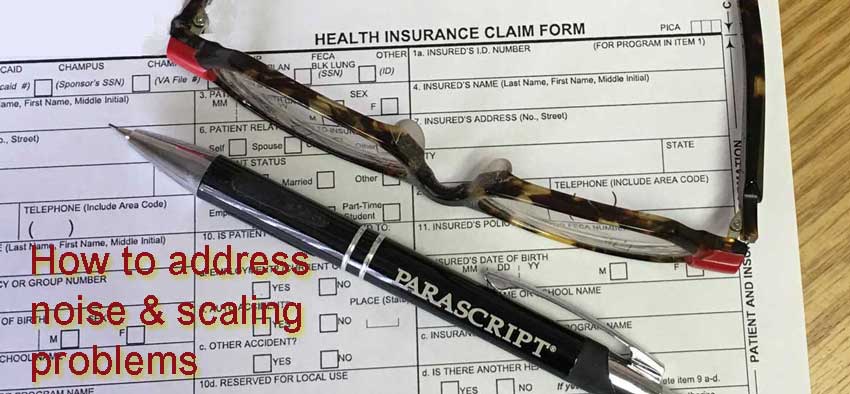When it comes to document processing, there’s an area that is still in trouble, surprisingly: claims processing involving faxed and black/white printed structured forms. While a lot of attention over the past decade has been focused on the problems of unstructured data and the benefits of applying technology to classify and extract critical information, structured forms processing still has a significant labor component when it comes to claims processing.
Facing the Challenges in Claims Processing
What are the challenges in processing claims? While these are structured forms, serious challenges exist in dealing with excessive “noise” and scaling problems that turn an otherwise very standardized form into a version that practically requires 100 percent manual data entry.
Scaling – The Fax, a Big Culprit
Let’s start with scaling. Faxing documents is the biggest culprit. Fax machines, while having a standardized protocol, have wide variances when it comes to image quality and how those images are delivered. Many fax machines apply additional data that effectively shifts the data up, down and side-to-side. How it shifts varies; this is determined by both the hardware and the configuration made by the end user. And then, scaling settings are often applied erratically. The result is images that are up to 80 percent of the original size. These two factors often render the ability to use pre-defined templates all, but impossible. Either that, or potentially hundreds of templates must be managed to account for all the variants. Even then, the software often can apply the incorrect template. As a result, most of these documents go straight to manual data entry.
Noise Impacts Results
Now let’s discuss the noise. Faxes are the most obvious, as the quality of images can deteriorate based on the sending and the receiving technologies. Since the claim form is a “dense” form packed with fields, introduction of any type of smudge or speckles can significantly effect the ability for the software to locate and correctly extract the data. A second issue is the form structure. Claim forms that use drop-out inks allow the form itself to be completely removed. This allows the software to do its thing without any obstructions. If data is not aligned and overlaps a box, this presents no problem since the box is removed leaving only the data. However, when the structure remains, there is potential to “confuse” the software by forcing it to deal with these other elements. If a vertical line is too close to the data, the software might erroneously add a character.
Technology to Deal Effectively with Issues
Fortunately, technology exists to deal effectively with structured forms so that they are improved to account for additional complexities.
For instance, scaling can be efficiently handled. Rather than rigid registration functions that attempt to align an incoming form precisely with a template, there is technology that can actually analyze the form and adjust the form to fit a template, and do so, on a line-by-line basis. Sometimes there is distortion of the document that results in a portion of the form being “stretched” or “squeezed.” Using a non-linear approach allows the image to be corrected before it is aligned to a template resulting in a much higher percentage of forms that can be processed automatically.
Field-level Clean-up with Advanced Data Extraction
As for the challenges of noise, technology exists to apply the fine-tuned removal of both smudges and other noise as well as form structure, not simply at the page level, but at the field level. This is important because if there is an alignment issue, removal of the form structure as a whole will not work at all or worse, it will remove important data. Field-level cleanup of structures and pre-printed text have the overall effect of significantly improving data extraction. While not as exact as the highly precise extraction of drop-out ink forms, the overall improvement can move to within 10 percent to 15 percentage points and that is a pronounced improvement over current levels.
Yet a third technology that can be applied is field-level OCR that examines data at the character and the word level. This type of technology can overcome the poor quality text often present with faxed forms and those forms that are printed using lower-quality hardware.
Most organizations that process claims have these problems associated with black and white claim forms and the good news is, the technology is here to significantly improve your operations and save a lot of money in the process.

